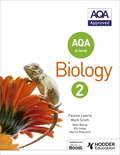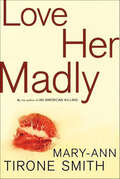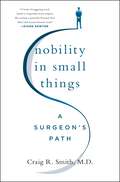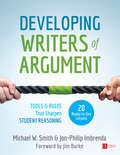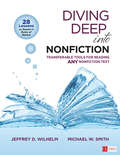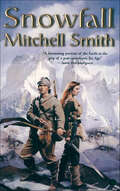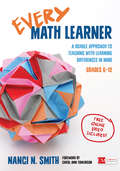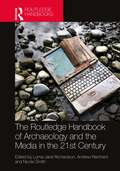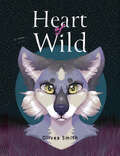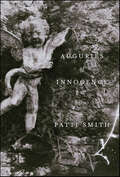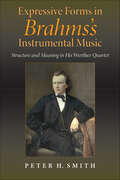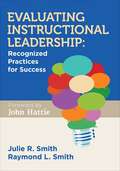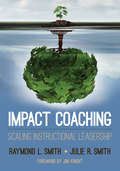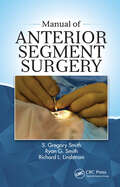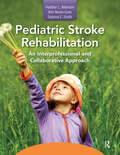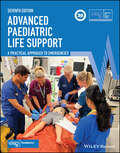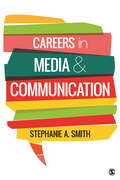- Table View
- List View
AQA A Level Biology Student Book 2
by Mark Smith Pauline LowrieExam Board: AQALevel: AS/A-levelSubject: BiologyFirst Teaching: September 2015First Exam: June 2017Develop students' experimental, analytical and evaluation skills with contemporary and topical biology examples, practical assessment guidance and differentiated end of topic questions, with this AQA Year 2 student book.- Provides support for all 12 required practicals with plenty of activities and data analysis guidance- Develops understanding with engaging and contemporary examples to help students apply their knowledge, analyse data and evaluate findings- Gives detailed guidance and examples of method with a dedicated 'Maths in Biology' chapter and mathematical support throughout to consolidate learning- Offers regular opportunities to test understanding with Test Yourself Questions, Differentiated End of Topic Questions and Stretch and Challenge Questions- Supports exam preparation with synoptic questions, revision tips and skills-Develops understanding with free online access to 'Test yourself' answers and an extended glossary.
AQA A Level Biology Student Book 2
by Mark Smith Pauline LowrieExam Board: AQALevel: AS/A-levelSubject: BiologyFirst Teaching: September 2015First Exam: June 2017Develop students' experimental, analytical and evaluation skills with contemporary and topical biology examples, practical assessment guidance and differentiated end of topic questions, with this AQA Year 2 student book.- Provides support for all 12 required practicals with plenty of activities and data analysis guidance- Develops understanding with engaging and contemporary examples to help students apply their knowledge, analyse data and evaluate findings- Gives detailed guidance and examples of method with a dedicated 'Maths in Biology' chapter and mathematical support throughout to consolidate learning- Offers regular opportunities to test understanding with Test Yourself Questions, Differentiated End of Topic Questions and Stretch and Challenge Questions- Supports exam preparation with synoptic questions, revision tips and skills-Develops understanding with free online access to 'Test yourself' answers and an extended glossary.
Love Her Madly: A Novel (The Poppy Rice Mysteries #1)
by Mary-Ann Tirone SmithA tense, death-row drama--meet brash FBI investigator Poppy Rice in Love Her Madly, the first of a winning new series by Mary-Ann Tirone SmithPoppy Rice is home in her D.C. apartment with very little furniture and lots of boxes she still hasn't unpacked after five years. It's three a.m. and she's suffering from her usual insomnia. While polishing her nails, she watches a tape of the CBS Evening News--Dan Rather is interviewing convicted ax-murderer Rona Leigh Glueck. In ten days, Rona Leigh will be the first woman executed in Texas since the Civil War. Poppy pauses the tape on a close-up of Rona Leigh's small, delicate hands. Okay, she thinks, so maybe it was a lightweight ax.Poppy digs out Rona Leigh's case file to find--along with the grisly crime-scene photos--a physician's testimony that glee, not muscle, gave her the strength to commit the crime. When her public defender asked the crime lab for help determining whether such a small woman could physically commit these murders, he was turned away for not filing the correct paperwork.With the reluctant support of her colleague and sometime lover, Joe Barnow, the relentless Poppy reopens the investigation to find out if Rona Leigh deserves to receive a certificate that will read: Death by Legal Homicide as Ordered by the State of Texas.Funny and fearless, Poppy Rice is just about unstoppable.
Nobility in Small Things: A Surgeon's Path
by Craig R. Smith M.D.His routine was the same every day for 38 years: up at 4:15, make a turkey-on-rye, drive the deserted Henry Hudson Parkway to the hospital, check the schedule, scrub, cut, reattach, save a life or two, repeat. Until March 2020, when the Covid-19 pandemic shut hospital surgeries all over the world.Craig Smith, M.D., Chairman of the Department of Surgery at Columbia Presbyterian Hospital, went from performing heart surgeries on patients both everyday and celebrated (he performed the quadruple bypass that saved Bill Clinton’s life in 2004) to sitting in his tomb-quiet office looking out at George Washington Bridge. And he started to write. His Covid emails were balm to the staffers and later became celebrated for Dr. Smith’s care and thought in his assessment of the work of the hospital–of any hospital.Nobility in Small Things not only takes us into the mind and soul of a surgeon with the ability to “play God” but into the heart of a man who chose a lifesaving career. The book introduces us to patients and peers, and moves from family-building and heartbreak at home, to the tragic suicide of two fellow M.D.s. Dr. Smith also writes vulnerably about his debilitating social anxiety and how he overcame it.Dr. Smith shows us not just the making of a surgeon in Nobility in Small Things, but the maintenance of one: the deep feeling and moral philosophy that anchor the daily miracles that define his profession.
Developing Writers of Argument: Tools and Rules That Sharpen Student Reasoning (Corwin Literacy)
by Michael W. Smith Jon-Philip ImbrendaThe ability to make effective arguments is not only necessary in students’ academic lives, it’s a transferable skill that’s essential to students’ future success as critical thinkers and contributing members of society. But in the here and now, how do we engage students and ensure they understand argument writing’s fundamental components? How do we take them from "Here’s what I think" to "Here’s what I think. Here’s what makes me think that. And here’s why it matters"? This stunning, full-color book by Michael Smith and Jon-Philip Imbrenda shows the way, with ready-to-implement lessons that make argument writing topical and relevant. Students are first asked to form arguments about subjects that matter to them, and then to reflect on the structure of those arguments, a process that provides learners with valuable, reusable structural models. Throughout the book, the authors provide helpful instructional tools, including Literary, nonfiction, and author-created simulated texts that inspire different points of view Essential questions to create a context that rewards argumentation Lessons introducing students to the three essential elements of an argument—claim, data, and warrant—and how to make each effective Questioning probes, semantic differential scales, and other innovative instructional approaches Samples of writing from the authors’ own students, and enlightening details on how this work informed the authors’ subsequent teaching approach Complete with guidance on applying the lessons’ techniques in a broader, unit-wide context, Developing Writers of Argument offers a practical approach for instructing students in this crucial aspect of their lifelong development.
Developing Writers of Argument: Tools and Rules That Sharpen Student Reasoning (Corwin Literacy)
by Michael W. Smith Jon-Philip ImbrendaThe ability to make effective arguments is not only necessary in students’ academic lives, it’s a transferable skill that’s essential to students’ future success as critical thinkers and contributing members of society. But in the here and now, how do we engage students and ensure they understand argument writing’s fundamental components? How do we take them from "Here’s what I think" to "Here’s what I think. Here’s what makes me think that. And here’s why it matters"? This stunning, full-color book by Michael Smith and Jon-Philip Imbrenda shows the way, with ready-to-implement lessons that make argument writing topical and relevant. Students are first asked to form arguments about subjects that matter to them, and then to reflect on the structure of those arguments, a process that provides learners with valuable, reusable structural models. Throughout the book, the authors provide helpful instructional tools, including Literary, nonfiction, and author-created simulated texts that inspire different points of view Essential questions to create a context that rewards argumentation Lessons introducing students to the three essential elements of an argument—claim, data, and warrant—and how to make each effective Questioning probes, semantic differential scales, and other innovative instructional approaches Samples of writing from the authors’ own students, and enlightening details on how this work informed the authors’ subsequent teaching approach Complete with guidance on applying the lessons’ techniques in a broader, unit-wide context, Developing Writers of Argument offers a practical approach for instructing students in this crucial aspect of their lifelong development.
Diving Deep Into Nonfiction, Grades 6-12: Transferable Tools for Reading ANY Nonfiction Text (Corwin Literacy)
by Michael W. Smith Jeffrey D. Wilhelm"General reading strategies and teacher-developed questions will only take our students so far—with our approach, students gain astounding independence because they engage directly with the nonfiction author, and with how that author used specific details (moves) and structures to communicate meanings and effects." —Wilhelm and Smith All nonfiction is a conversation between the writer and the reader, an invitation to agree or disagree with compelling and often provocative ideas about some aspect of the world we live in. At the end of the day, it’s our responsibility to decide if the argument is sound. With Diving Deep Into Nonfiction, Jeffrey D. Wilhelm and Michael W. Smith deliver a revolutionary teaching framework that helps students read well by noticing the rules and conventions of this dynamic exchange. The classroom-tested lessons include engaging short excerpts and teach students to be powerful readers who know both how authors signal what’s worth noticing in a text and how readers connect and make meaning of what they have noticed. No matter what they are reading, students learn to be on high alert, and highly curious about how texts work and what they mean, as they learn to notice direct statements of principle, calls to attention, ruptures, and readers’ rules of notice: Notice the topics and the textual conversation: Who is speaking and how might he or she be responding to another’s ideas? What is the idea that gives "heat" to this text? Notice key details: What attracts my attention? How does the author signal both direct and implicit statements of meaning? How does the author use the unexpected? How can I interpret patterns of key details to see overall meanings? Notice varied nonfiction genres: What are the essential features of this kind of text? How does the author employ them? What effects are they designed to have on the reader? Notice text structure: How does the author structure the text to connect details and ideas? What patterns of thought does the author use along the way? With Diving Deep Into Nonfiction, Wilhelm and Smith upend current practices, and it’s high time. Once your students engage with these lessons, you’ll never go back to the same old tired approach— and reading across content areas enters a whole new era.
Diving Deep Into Nonfiction, Grades 6-12: Transferable Tools for Reading ANY Nonfiction Text (Corwin Literacy)
by Michael W. Smith Jeffrey D. Wilhelm"General reading strategies and teacher-developed questions will only take our students so far—with our approach, students gain astounding independence because they engage directly with the nonfiction author, and with how that author used specific details (moves) and structures to communicate meanings and effects." —Wilhelm and Smith All nonfiction is a conversation between the writer and the reader, an invitation to agree or disagree with compelling and often provocative ideas about some aspect of the world we live in. At the end of the day, it’s our responsibility to decide if the argument is sound. With Diving Deep Into Nonfiction, Jeffrey D. Wilhelm and Michael W. Smith deliver a revolutionary teaching framework that helps students read well by noticing the rules and conventions of this dynamic exchange. The classroom-tested lessons include engaging short excerpts and teach students to be powerful readers who know both how authors signal what’s worth noticing in a text and how readers connect and make meaning of what they have noticed. No matter what they are reading, students learn to be on high alert, and highly curious about how texts work and what they mean, as they learn to notice direct statements of principle, calls to attention, ruptures, and readers’ rules of notice: Notice the topics and the textual conversation: Who is speaking and how might he or she be responding to another’s ideas? What is the idea that gives "heat" to this text? Notice key details: What attracts my attention? How does the author signal both direct and implicit statements of meaning? How does the author use the unexpected? How can I interpret patterns of key details to see overall meanings? Notice varied nonfiction genres: What are the essential features of this kind of text? How does the author employ them? What effects are they designed to have on the reader? Notice text structure: How does the author structure the text to connect details and ideas? What patterns of thought does the author use along the way? With Diving Deep Into Nonfiction, Wilhelm and Smith upend current practices, and it’s high time. Once your students engage with these lessons, you’ll never go back to the same old tired approach— and reading across content areas enters a whole new era.
Snowfall: Book Three Of The Snowfall Trilogy (The Snowfall Trilogy #3)
by Mitchell SmithSnowfall features another sharp-tongued, uncompromising heroine, Catania Olsen. She is the doctor for and spiritual guardian of a band of hunters who live at the edge of a great Wall of ice in what was once Colorado. In the country of the Trappers, books are hand-copied so that knowledge may be preserved, but the technology described in their precious pages is mostly lost to their fur-clad readers, despite Catania's attempts at scientific treatment and the Trappers' careful husbanding of ancient metal tools.As a resurgent population moves west and north from the more settled places that had once been the Eastern Seaboard and Gulf Coast of the United States, they drive tribesmen-Cree, Arapaho, and more-before them. On the run and desperate to find new homes, the tribes slaughter entire populations to claim their lands. The Trappers are innocent of this until Jack Monroe, banished years before for murdering a fellow Trapper, arrives, urging them to flee their ancestral home, the Trappers do not listen until nearly too late, until the first enemy arrows have found their marks.The southern flight of the surviving Trappers is a journey through time as well as space. From a frozen northland where summer lasts two chilly weeks through a burgeoning forest where the Trappers taste their first beef to a gulf coast where warm breezes carry exotic scents and sounds; from a primitive life of hunting and trapping to the luxurious Gardens, where people can still weave and make paper, to a bustling trade mart where man-beasts created by unnatural science tread the dirt streets, Catania is shocked to recognize that the proud Trappers have spent generations clinging to civilization with their fingernails. The journey into the warm lands will change Doctor Catania Olsen, mind, heart, and soul. She will gain and lose a love, see great wisdom and greater folly, witness amazing miracles and terrifying science, and, most surprising to herself, become a mother. Finally, she will have to choose between her people and her freedom. At the Publisher's request, this title is being sold without Digital Rights Management Software (DRM) applied.
Every Math Learner, Grades 6-12: A Doable Approach to Teaching With Learning Differences in Mind (Corwin Mathematics Series)
by Nanci N. SmithAs a secondary mathematics teacher, you know that students are different and learn differently. And yet, when students enter your classroom, you somehow must teach these unique individuals deep mathematics content using rigorous standards. The curriculum is vast and the stakes are high. Is differentiation really the answer? How can you make it work? Nationally recognized math differentiation expert Nanci Smith debunks the myths, revealing what differentiation is and isn’t. In this engaging book Smith reveals a practical approach to teaching for real learning differences. You’ll gain insights into an achievable, daily differentiation process for ALL students. Theory-lite and practice-heavy, this book shows how to maintain order and sanity while helping your students know, understand, and even enjoy doing mathematics. Classroom videos, teacher vignettes, ready-to-go lesson ideas and rich mathematics examples help you build a manageable framework of engaging, sense-making math. Busy secondary mathematics teachers, coaches, and teacher teams will learn to Provide practical structures for assessing how each of your students learns and processes mathematics concepts Design, implement, manage, and formatively assess and respond to learning in a differentiated classroom Plan specific, standards-aligned differentiated lessons, activities, and assessments Adjust current instructional materials and program resources to better meet students′ needs This book includes classroom videos, in-depth student work samples, student surveys, templates, before-and-after lesson demonstrations, examples of 5-day sequenced lessons, and a robust companion website with downloadables of all the tools in the books plus other resources for further planning. Every Math Learner, Grades 6-12 will help you know and understand your students as learners for daily differentiation that accelerates their mathematics comprehension. "This book is an excellent resource for teachers and administrators alike. It clearly explains key tenants of effective differentiation and through an interactive approach offers numerous practical examples of secondary mathematics differentiation. This book is a must read for any educator looking to reach all students." —Brad Weinhold, Ed.D., Assistant Principal, Overland High School
Every Math Learner, Grades 6-12: A Doable Approach to Teaching With Learning Differences in Mind (Corwin Mathematics Series)
by Nanci N. SmithAs a secondary mathematics teacher, you know that students are different and learn differently. And yet, when students enter your classroom, you somehow must teach these unique individuals deep mathematics content using rigorous standards. The curriculum is vast and the stakes are high. Is differentiation really the answer? How can you make it work? Nationally recognized math differentiation expert Nanci Smith debunks the myths, revealing what differentiation is and isn’t. In this engaging book Smith reveals a practical approach to teaching for real learning differences. You’ll gain insights into an achievable, daily differentiation process for ALL students. Theory-lite and practice-heavy, this book shows how to maintain order and sanity while helping your students know, understand, and even enjoy doing mathematics. Classroom videos, teacher vignettes, ready-to-go lesson ideas and rich mathematics examples help you build a manageable framework of engaging, sense-making math. Busy secondary mathematics teachers, coaches, and teacher teams will learn to Provide practical structures for assessing how each of your students learns and processes mathematics concepts Design, implement, manage, and formatively assess and respond to learning in a differentiated classroom Plan specific, standards-aligned differentiated lessons, activities, and assessments Adjust current instructional materials and program resources to better meet students′ needs This book includes classroom videos, in-depth student work samples, student surveys, templates, before-and-after lesson demonstrations, examples of 5-day sequenced lessons, and a robust companion website with downloadables of all the tools in the books plus other resources for further planning. Every Math Learner, Grades 6-12 will help you know and understand your students as learners for daily differentiation that accelerates their mathematics comprehension. "This book is an excellent resource for teachers and administrators alike. It clearly explains key tenants of effective differentiation and through an interactive approach offers numerous practical examples of secondary mathematics differentiation. This book is a must read for any educator looking to reach all students." —Brad Weinhold, Ed.D., Assistant Principal, Overland High School
The Routledge Handbook of Archaeology and the Media in the 21st Century
by Nicole Smith Andrew Reinhard Lorna-Jane RichardsonThe Routledge Handbook of Archaeology and the Media in the 21st Century presents diverse international perspectives on what it means to be an archaeologist and to conduct archaeological research in the age of digital and mobile media.This volume analyses the present‑day use of new and old media by professional and academic archaeology for leisure, academic study and/or public engagement, and attempts to provide a broad survey of the use of media in a wider global archaeological context. It features work on traditional paper media, radio, podcasting, film, television, contemporary art, photography, video games, mobile technology, 3D image capture, digitization and social media. Themes explored include archaeology and traditional media, archaeology in a digital age, archaeology in a post‑truth era and the future of archaeology. Such comprehensive coverage has not been seen before, and the focus on 21st‑century concerns and media consumption practices provides an innovative and original approach.The Routledge Handbook of Archaeology and the Media in the 21st Century updates the interdisciplinary field of media studies in archaeology and will appeal to students and researchers in multiple fields including contemporary, public, digital, and media archaeology, and heritage studies and management. Television and film producers, writers and presenters of cultural heritage will also benefit from the many entanglements shared here between archaeology and the contemporary media landscape.
Heart of Wild
by Olivea Smith“Here it was. The forest’s edge. No one had ever dared to set paw here.” When a young wolf named Minty is forced to leave his pack and everything he’s ever known, he must venture on an epic journey to find himself a new home and life, far from the wolves who haunt his past. As he travels through the new world evolving around him, he encounters many challenges, and becomes faced with the ultimate choice; return to the pack and rival his greatest enemy to save his pack, or continue running from his fears. Will he make it back home in time to save the ones he loves from a great evil, or will he leave them to face this threat themselves and carry on the life of a lone wolf? Come join the world of a wild wolf and discover a wilderness of both wonder and woe, as Minty embarks on a quest throughout the dark and mysterious forest, meeting new and dangerous challenges around every twist and turn.
Auguries of Innocence: Poems
by Patti SmithAuguries of Innocence is the first book of poetry from Patti Smith in more than a decade. It marks a major accomplishment from a poet and performer who has inscribed her vision of our world in powerful anthems, ballads, and lyrics. In this intimate and searing collection of poems, Smith joins in that great tradition of troubadours, journeymen, wordsmiths, and artists who respond to the world around them in fresh and original language. Her influences are eclectic and striking: Blake, Rimbaud, Picasso, Arbus, and Johnny Appleseed. Smith is an American original; her poems are oracles for our times.
Expressive Forms in Brahms's Instrumental Music: Structure and Meaning in His Werther Quartet (Musical Meaning and Interpretation)
by Peter H. Smith"This book is a substantial and timely contribution to Brahms studies. Its strategy is to focus on a single critical work, the C-Minor Piano Quartet, analyzing and interpreting it in great detail, but also using it as a stepping-stone to connect it to other central Brahms works in order to reach a new understanding of the composer's technical language and expressive intent. It is an original and worthy contribution on the music of a major composer." —Patrick McCrelessExpressive Forms in Brahms's Instrumental Music integrates a wide variety of analytical methods into a broader study of theoretical approaches, using a single work by Brahms as a case study. On the basis of his findings, Smith considers how Brahms's approach in this piano quartet informs analyses of similar works by Brahms as well as by Beethoven and Mozart.Musical Meaning and Interpretation—Robert S. Hatten, editor
Evaluating Instructional Leadership: Recognized Practices for Success
by Raymond L. Smith Julie Rae SmithImprove principal evaluation and create highly effective leaders! Even with great teachers, student achievement hinges on an effective principal. Behind every high-quality principal is an airtight system of leadership evaluation that consistently rewards excellence and remedies deficits. While teacher evaluation methods have improved, instructional leadership evaluation has often stood still—and student learning and achievement have paid the price. This book identifies the major problems in this process and articulates clear solutions. The result is a blueprint for ensuring the best person for the job is occupying the principal’s chair. Content includes: Extensive data, presented in a user-friendly manner Clear connections to the ISLLC Standards for School Leaders A suite of interactive tools including sample self-assessments, mid-year and final evaluation forms, and professional growth plans "This book not only highlights the key messages about the role of the leader, but it is does so in a way that is engaging, practical, and reflects the Smiths’ long history of being school leaders, teaching school leaders, and seeing the effects of their teaching. I have seen the Smiths in action, separately and together, and they know how to lead and how to teach, they have a strength of purpose they do not waver from, and these attributes come through in this book." -John Hattie, Director Melbourne Education Research Institute, University of Melbourne "After reading this book, you′ll truly understand what it takes to grow as a lead learner. We can always get better. This book provides quality insight on strategies that will make good leaders great." -Brad Currie, School Leader, Corwin Author and Co-Founder of #Satchat
Evaluating Instructional Leadership: Recognized Practices for Success
by Raymond L. Smith Julie Rae SmithImprove principal evaluation and create highly effective leaders! Even with great teachers, student achievement hinges on an effective principal. Behind every high-quality principal is an airtight system of leadership evaluation that consistently rewards excellence and remedies deficits. While teacher evaluation methods have improved, instructional leadership evaluation has often stood still—and student learning and achievement have paid the price. This book identifies the major problems in this process and articulates clear solutions. The result is a blueprint for ensuring the best person for the job is occupying the principal’s chair. Content includes: Extensive data, presented in a user-friendly manner Clear connections to the ISLLC Standards for School Leaders A suite of interactive tools including sample self-assessments, mid-year and final evaluation forms, and professional growth plans "This book not only highlights the key messages about the role of the leader, but it is does so in a way that is engaging, practical, and reflects the Smiths’ long history of being school leaders, teaching school leaders, and seeing the effects of their teaching. I have seen the Smiths in action, separately and together, and they know how to lead and how to teach, they have a strength of purpose they do not waver from, and these attributes come through in this book." -John Hattie, Director Melbourne Education Research Institute, University of Melbourne "After reading this book, you′ll truly understand what it takes to grow as a lead learner. We can always get better. This book provides quality insight on strategies that will make good leaders great." -Brad Currie, School Leader, Corwin Author and Co-Founder of #Satchat
Impact Coaching: Scaling Instructional Leadership
by Raymond L. Smith Julie Rae SmithInvest in building talent. The best principals don’t just happen. When new principals are handed the keys and left to make decisions about their schools without adequate, sustained support, what happens? Too often, school improvement efforts don’t gain full traction, principals often give up and leave and real student gains remain out-of-reach. Impact Coaching bucks the notion of leaving principals to learn the ropes on their own. This book offers a solid, sustainable, and laser-sharp focus on instructional leadership and helps leaders hone, model and lead new learning through deliberate practice by: Engaging in rich, rigorous, and reflective open-to-learning conversations with both coaches and colleagues to improve instructional leadership practices Leveraging their 5 Big Winner Practices for highest impact Using Linking Walk templates to apply new ideas to real scenarios that improve lead learner practices This book could be your single most impactful investment toward eventual student achievement. "The authors do a great job of sharing the benefits of coaching and elaborating on how the coaching partnership should and could look. The book is very relevant, clearly based on research, and has some great checklists to further clarify the recommended steps." –Kathy Rhodes, Principal Hinton Elementary, Hinton, IA "Impact Coaching provides school leaders with the tools to turn opportunity into action. Educational leaders possess an incredible capacity to influence the system and impact student learning. Ray and Julie Smith present strategies for focusing on leadership practices that maximize impact on student learning and achievement. This book will re-ignite your commitment to creating effective change, bolster your confidence to persist through challenges, and renew your motivation to reach your fullest potential. The authors will simultaneously inspire your soul and challenge your mind!" –Russell J. Quaglia, President/Founder Quaglia Institute for Student Aspirations
Impact Coaching: Scaling Instructional Leadership
by Raymond L. Smith Julie Rae SmithInvest in building talent. The best principals don’t just happen. When new principals are handed the keys and left to make decisions about their schools without adequate, sustained support, what happens? Too often, school improvement efforts don’t gain full traction, principals often give up and leave and real student gains remain out-of-reach. Impact Coaching bucks the notion of leaving principals to learn the ropes on their own. This book offers a solid, sustainable, and laser-sharp focus on instructional leadership and helps leaders hone, model and lead new learning through deliberate practice by: Engaging in rich, rigorous, and reflective open-to-learning conversations with both coaches and colleagues to improve instructional leadership practices Leveraging their 5 Big Winner Practices for highest impact Using Linking Walk templates to apply new ideas to real scenarios that improve lead learner practices This book could be your single most impactful investment toward eventual student achievement. "The authors do a great job of sharing the benefits of coaching and elaborating on how the coaching partnership should and could look. The book is very relevant, clearly based on research, and has some great checklists to further clarify the recommended steps." –Kathy Rhodes, Principal Hinton Elementary, Hinton, IA "Impact Coaching provides school leaders with the tools to turn opportunity into action. Educational leaders possess an incredible capacity to influence the system and impact student learning. Ray and Julie Smith present strategies for focusing on leadership practices that maximize impact on student learning and achievement. This book will re-ignite your commitment to creating effective change, bolster your confidence to persist through challenges, and renew your motivation to reach your fullest potential. The authors will simultaneously inspire your soul and challenge your mind!" –Russell J. Quaglia, President/Founder Quaglia Institute for Student Aspirations
Manual of Anterior Segment Surgery
by S Gregory Smith Ryan Smith Richard LindstromMicroscopic surgery requires complicated maneuvers. There are often photos, videos, and descriptions of what the instruments are doing. However, there are ways to set yourself up for success in ophthalmic surgical techniques. Inside the Manual of Anterior Segment Surgery is the wisdom of over 4 decades of surgical experience by Drs. Gregory Smith, Ryan Smith, and Richard Lindstrom covering the essentials of anterior segment surgery. Through this experience, one of the key ingredients in setting yourself up for success is the position of your hands with relation to the instrument and what you are trying to accomplish with the instrument. In a concise yet detailed manner, the basics of microscope management, patient head position, surgeon hand position, the relationship of the instrument and the hands, and how to enhance the performance of every surgical maneuver are covered with helpful illustrations. Designed to enhance your surgical techniques by putting you in a position to succeed, this manual will show you how to make the complex maneuvers look simple and improve patient outcomes. The Manual of Anterior Segment Surgery is a method to shorten your timeline to excellent surgery
Pediatric Stroke Rehabilitation: An Interprofessional and Collaborative Approach
by Sabrina Smith Heather Atkinson Kim Nixon-CavePediatric Stroke Rehabilitation: An Interprofessional and Collaborative Approach is a groundbreaking text designed to enhance the practice of all health care providers, enrich discussion, and emphasize the interdisciplinary nature of managing best outcomes for a child who has had a stroke. Evidence-based practice is threaded throughout the text with an emphasis on recovery vs. compensation, goal achievement, and outcome measurement.In conjunction with the interdisciplinary contributions from a wide variety of health care professionals, Drs. Heather Atkinson, Kim Nixon-Cave, and Sabrina E. Smith aim to provide the necessary tools to effectively treat children with stroke.The first section reviews the medical fundamentals, covering all major types of strokes. The second section of Pediatric Stroke Rehabilitation focuses on the core of the matter, rehabilitation. The final section expands the understanding of the child’s recovery to the family, community, and school environment.Select chapters include: Personal vignettes written by family members of children who have had a stroke that provides insight into the impact a stroke can have on the child and family A family focus box to summarize the main points of the chapter to provide the best tools for caregivers to advocate for their child A case study related to the content and family perspective Pediatric Stroke Rehabilitation also utilizes the World Health Organization’s International Classification of Functioning, Disability, and Health (ICF) framework throughout.Included with the text are online supplemental materials for faculty use in the classroom.Pediatric Stroke Rehabilitation: An Interprofessional and Collaborative Approach is an interdisciplinary and invaluable resource for students and clinicians to understand and apply effective evidence-based practice and treatment approaches for childhood stroke. The text will also be of interest to healthcare professionals, specifically physical therapists, occupational therapists, speech-language pathologists, physicians, neuropsychologists, nurses, and educators, who work with children who have experienced a stroke.
What Can You See in Summer? (Seasons Ser.)
by Sian SmithBooks in this series introduce emergent readers to the four seasons. In Summer, children are taken on a tour of things they can see in summer including typical summer activities and changes in the natural world. Beautiful photos, very simple repeated text, high frequency and decodeable words and strong photo-to-text matching make this a perfect book for early readers to enjoy.
Advanced Paediatric Life Support: A Practical Approach to Emergencies (Advanced Life Support Group)
by Stephanie SmithADVANCED PAEDIATRIC LIFE SUPPORT A PRACTICAL APPROACH TO EMERGENCIES The gold standard for treating paediatric emergencies Advanced Paediatric Life Support: A Practical Approach to Emergencies is the internationally renowned manual on emergency paediatric care. Written to support the course run by the Advanced Life Support Group, the book uses their structured approach: a tried and tested practical method of treating children during the crucial first few hours of a life-threatening illness or injury. Advanced Paediatric Life Support is used by doctors, nurses and allied health professionals dealing with emergencies in children. Its clear layout and straightforward style make it a highly practical tool both for training and in the event of an emergency. In the seventh edition you will find descriptions of both common and uncommon paediatric emergencies which you may encounter in clinical practice, their causes, and how to best treat them during the first hours after presentation. This book offers a thoroughly evidence-based approach to its subject, which includes: The latest International Liaison Committee on Resuscitation (ILCOR) 2021 guidelines A thorough introduction to the structured approach to paediatric emergencies, including important non-technical skills and communication Comprehensive explorations of the seriously ill child, including airway and breathing, circulation, decreased consciousness, seizures and exposure Practical discussions of the seriously injured child, including examinations of chest, abdominal, brain and spinal injuries Evidence-based life support treatment and the practical application of the Advanced Paediatric Life Support structured management Perfect for emergency care physicians, nurses and other allied health professionals, Advanced Paediatric Life Support: A Practical Approach to Emergencies will also benefit paediatric clinicians, doctors-in-training and anyone else with an interest in the team management and treatment of paediatric emergencies.
Careers in Media and Communication
by Stephanie A. SmithCareers in Media and Communication is a practical resource that helps students understand how a communication degree prepares them for a range of fulfilling careers; it gives students the skills they will need to compete in a changing job market. Award-winning teacher and author Stephanie A. Smith draws from her years of professional experience to guide students through the trends and processes of identifying, finding, and securing a job in in mass communication. Throughout the book, students explore the daily lives of professionals currently working in the field, as well as gain firsthand insights into the training and experience that hiring managers seek.
Careers in Media and Communication
by Stephanie A. SmithCareers in Media and Communication is a practical resource that helps students understand how a communication degree prepares them for a range of fulfilling careers; it gives students the skills they will need to compete in a changing job market. Award-winning teacher and author Stephanie A. Smith draws from her years of professional experience to guide students through the trends and processes of identifying, finding, and securing a job in in mass communication. Throughout the book, students explore the daily lives of professionals currently working in the field, as well as gain firsthand insights into the training and experience that hiring managers seek.
